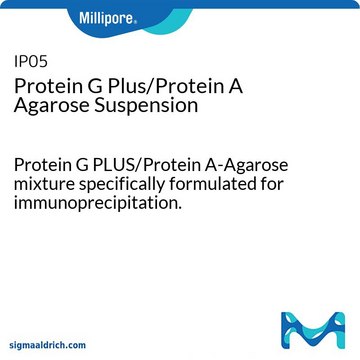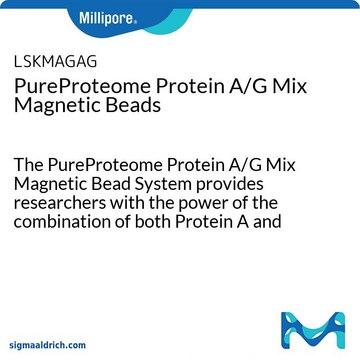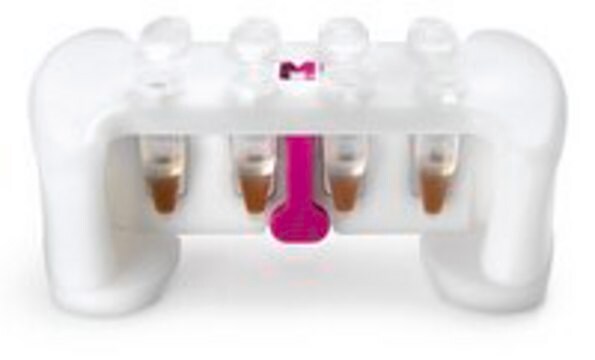17-613
ChIPAb+ p53 - ChIP Validated Antibody and Primer Set
from mouse
Sign Into View Organizational & Contract Pricing
All Photos(2)
About This Item
UNSPSC Code:
12352203
eCl@ss:
32160702
NACRES:
NA.52
Recommended Products
General description
All ChIPAb+ antibodies are individually validated for chromatin precipitation, every lot, every time. Each ChIPAb+ antibody set includes control primers (tested every lot by qPCR) to biologically validate your IP results in a locus-specific context. The qPCR protocol and primer sequences are provided, allowing researchers to validate ChIP protocols when using our antibody in their chromatin context. Each set also includes a negative control antibody to ensure specificity of the ChIP reaction.
The ChIPAb+ p53 set includes the p53 antibody raised against recombinant human p53, the negative control antibody (mouse normal IgG), and qPCR primers flanking an Sp1 binding site (to which p53 can be recruited1) within the human p21 (WAF1/CIP1/CDKN1A) promoter, amplifying a 105 base pair PCR product. The p53 and negative control antibodies are supplied in a scalable "per ChIP" reaction size and can be used to functionally validate the precipitation of p53 associated chromatin.
The ChIPAb+ p53 set includes the p53 antibody raised against recombinant human p53, the negative control antibody (mouse normal IgG), and qPCR primers flanking an Sp1 binding site (to which p53 can be recruited1) within the human p21 (WAF1/CIP1/CDKN1A) promoter, amplifying a 105 base pair PCR product. The p53 and negative control antibodies are supplied in a scalable "per ChIP" reaction size and can be used to functionally validate the precipitation of p53 associated chromatin.
Specificity
Recognizes p53 in wild type and mutant forms of human origin.
Application
Chromatin Immunoprecipitation Analysis:
Sonicated chromatin prepared from untreated or actinomycin D treated (30 ng/mL, 6 hrs.) U2OS cells (3 X 106 cell equivalents per IP) was subjected to chromatin immunoprecipitation using 1 μg of mouse Anti-p53 and the Magna ChIP® G (Cat. # 17-611) Kit. Immunoprecipitation of p53 associated DNA fragments was verified by qPCR using ChIP Primers p21 flanking the human p21 promoter that contains an Sp1 binding site (Please see figures).
Fold Increase is a ratio of normalized mean IP quantities extracted from standard curves derived from inputs of each chromatin sample. As previously published, p53 association with this region of the p21 promoter increases upon actinomycin D treatment.
Chromatin Immunoprecipitation Analysis:
Sonicated chromatin prepared from untreated or UV treated (6 hrs, 50 joules/m2.) U2OS cells (3 X 106 cell equivalents per IP) was subjected to chromatin immunoprecipitation using 1 μg of mouse Anti-p53 and the Magna ChIP A (Cat. # 17-610) Kit.
Immunoprecipitation of p53 associated DNA fragments was verified by qPCR using ChIP Primers p21 flanking the human p21 promoter that contains an Sp1 binding site (Please see figures).
Fold Increase is a ratio of normalized mean IP quantities extracted from standard curves derived from inputs of each chromatin sample. p53 immunoprecipitable activity associated with this promoter increases with UV treatment as observed in other studies.
Sonicated chromatin prepared from untreated or actinomycin D treated (30 ng/mL, 6 hrs.) U2OS cells (3 X 106 cell equivalents per IP) was subjected to chromatin immunoprecipitation using 1 μg of mouse Anti-p53 and the Magna ChIP® G (Cat. # 17-611) Kit. Immunoprecipitation of p53 associated DNA fragments was verified by qPCR using ChIP Primers p21 flanking the human p21 promoter that contains an Sp1 binding site (Please see figures).
Fold Increase is a ratio of normalized mean IP quantities extracted from standard curves derived from inputs of each chromatin sample. As previously published, p53 association with this region of the p21 promoter increases upon actinomycin D treatment.
Chromatin Immunoprecipitation Analysis:
Sonicated chromatin prepared from untreated or UV treated (6 hrs, 50 joules/m2.) U2OS cells (3 X 106 cell equivalents per IP) was subjected to chromatin immunoprecipitation using 1 μg of mouse Anti-p53 and the Magna ChIP A (Cat. # 17-610) Kit.
Immunoprecipitation of p53 associated DNA fragments was verified by qPCR using ChIP Primers p21 flanking the human p21 promoter that contains an Sp1 binding site (Please see figures).
Fold Increase is a ratio of normalized mean IP quantities extracted from standard curves derived from inputs of each chromatin sample. p53 immunoprecipitable activity associated with this promoter increases with UV treatment as observed in other studies.
Research Category
Epigenetics & Nuclear Function
Epigenetics & Nuclear Function
Research Sub Category
Chromatin Biology
Chromatin Biology
This ChIPAb+ p53 -ChIP Validated Antibody & Primer Set conveniently includes the antibody & the specific control PCR primers.
Packaging
25 assays per kit. ~1 μg per chromatin immunoprecipitation
Quality
Routinely evaluated by chromatin immunoprecipitation and immunoblot on RIPA lysate of human Raji cells.
Target description
53 kDa
Physical form
Anti-p53 (mouse monoclonal IgG). One vial containing 25 μg of of protein A purified mouse IgG2a in 25 μL of storage buffer (PBS, pH 7.4, containing 0.05% sodium azide and 1 mg/mL BSA). Store at -20°C.
Normal Mouse IgG. One vial containing 25 μg of normal mouse IgG in 25 μL volume. Store at -20°C.
ChIP Primers p21. One vial containing 75 μL of 5 μM of each primer specific for a region of the human p21 (WAF1/CIP1/CDKN1A) promoter. Store at -20°C.
FOR: GTG GCT CTG ATT GGC TTT CTG
REV: CTG AAA ACA GGC AGC CCA AG
Normal Mouse IgG. One vial containing 25 μg of normal mouse IgG in 25 μL volume. Store at -20°C.
ChIP Primers p21. One vial containing 75 μL of 5 μM of each primer specific for a region of the human p21 (WAF1/CIP1/CDKN1A) promoter. Store at -20°C.
FOR: GTG GCT CTG ATT GGC TTT CTG
REV: CTG AAA ACA GGC AGC CCA AG
Format: Purified
Protein A purified
Storage and Stability
Stable for 1 year at -20°C from date of receipt
Analysis Note
Control
Included negative control antibody mouse normal IgG and control primers specific for human p21 (WAF1/CIP1/CDKN1A) promoter.
Included negative control antibody mouse normal IgG and control primers specific for human p21 (WAF1/CIP1/CDKN1A) promoter.
Legal Information
MAGNA CHIP is a registered trademark of Merck KGaA, Darmstadt, Germany
UPSTATE is a registered trademark of Merck KGaA, Darmstadt, Germany
Disclaimer
Unless otherwise stated in our catalog or other company documentation accompanying the product(s), our products are intended for research use only and are not to be used for any other purpose, which includes but is not limited to, unauthorized commercial uses, in vitro diagnostic uses, ex vivo or in vivo therapeutic uses or any type of consumption or application to humans or animals.
Storage Class Code
10 - Combustible liquids
Certificates of Analysis (COA)
Search for Certificates of Analysis (COA) by entering the products Lot/Batch Number. Lot and Batch Numbers can be found on a product’s label following the words ‘Lot’ or ‘Batch’.
Already Own This Product?
Find documentation for the products that you have recently purchased in the Document Library.
Neha Parikh et al.
The Journal of pathology, 232(5), 522-533 (2014-01-01)
Mutations in the TP53 tumour suppressor gene occur in half of all human cancers, indicating its critical importance in inhibiting cancer development. Despite extensive studies, the mechanisms by which mutant p53 enhances tumour progression remain only partially understood. Here, using
Yap Ching Chew et al.
The Journal of biological chemistry, 287(20), 16168-16178 (2012-03-20)
Sulforaphane (SFN) is an important cancer preventive agent derived from cruciferous vegetables. We show that SFN treatment suppresses normal human keratinocyte proliferation via a mechanism that involves increased expression of p21(Cip1). SFN treatment produces a concentration-dependent increase in p21(Cip1) promoter
Li Gao et al.
The Journal of biological chemistry, 293(10), 3780-3792 (2018-01-24)
The most frequently used oral anti-coagulant warfarin has been implicated in inducing calcification of aortic valve interstitial cells (AVICs), whereas the mechanism is not fully understood. The low-level activation of p53 is found to be involved in osteogenic transdifferentiation and
Gengze Wu et al.
Circulation, 130(17), 1452-1465 (2014-08-27)
Long noncoding RNAs (lncRNAs) have recently been implicated in many biological processes and diseases. Atherosclerosis is a major risk factor for cardiovascular disease. However, the functional role of lncRNAs in atherosclerosis is largely unknown. We identified lincRNA-p21 as a key
L Sauer et al.
Oncogene, 29(18), 2628-2637 (2010-03-02)
Early growth response-1 (Egr-1) is overexpressed in human prostate tumors and contributes to cancer progression. On the other hand, mutation of p53 is associated with advanced prostate cancer, as well as with metastasis and hormone independence. This study shows that
Our team of scientists has experience in all areas of research including Life Science, Material Science, Chemical Synthesis, Chromatography, Analytical and many others.
Contact Technical Service








